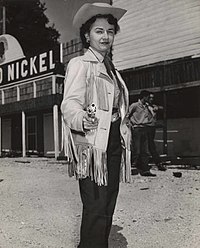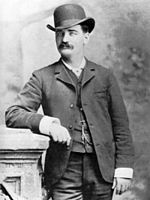Western wear

Western wear is a category of men's and women's clothing which derives its unique style from the clothes worn in the 19th century
Hat

In the early days of the
Stampede strings were installed to prevent the hat from being blown off when riding at speed. These long strings were usually made from leather or horsehair. Typically, the string was run half-way around the crown of a cowboy hat, and then through a hole on each side with its ends knotted and then secured under the chin or around the back of the head keeping the hat in place in windy conditions or when riding a horse.
The tall white
Originally part of the traditional
Shirt
A Western shirt is a traditional item of western wear characterized by a stylized
A Western
Another common type of Western shirt is the shield-front shirt worn by many US Cavalry troopers during the American Civil War but originally derived from a red shirt issued to prewar firefighters. The cavalry shirt was made of blue wool with yellow piping and brass buttons and was invented by the flamboyant George Armstrong Custer.[10] In recent times this shield-front shirt was popularised by John Wayne in Fort Apache and was also worn by rockabilly musicians like the Stray Cats.
In 1946, Papa Jack Wilde put snap buttons on the front, and pocket flaps on the Western shirt, and established
Coat
When a jacket is required there is a wide choice available for both linedancers and
For more formal occasions inhabitants of the West might opt for a suit with "smile" pockets, piping and a yoke similar to that on the Western shirts. This can take the form of an
Trousers


In the early days of the Wild West trousers were made out of wool. In summer canvas was sometimes used. This changed during the
Leather chaps were often worn to protect the cowboy's legs from cactus spines and prevent the fabric from wearing out.[18] Two common types include the skintight shotgun chaps[19] and wide batwing chaps. The latter were sometimes made from hides retaining their hair (known as "woolies") rather than tanned leather. They appeared on the Great Plains somewhere around 1887.[20]
Women wore knee-length
Neckwear

During the
Another well-known Western accessory, the
Footwear
See Cowboy boot
Image gallery
-
Will Rogers's western wear would inspire the clothing of the singing cowboys of the 1940s
-
Early use of the embroidered Western shirt by Buffalo Bill
-
A typical western shirt hasmother of pearl snap fasteners, two breast pockets, and a v-shaped motif.
-
fringe jacket
-
Mariachi singer wearing silver embroidered charro outfit
-
Example of the garish Western shirts popular in the 1970s and among the modern-day indie rock scene
-
Porter Wagoner wearing elaborateNudie suit
-
Annie Oakley wearing aprairie skirt
-
Authentichistorical reenactor in buckskins
-
Wild Bill wearing sombrero and frock coat
-
Authentic Stetsons from the 1880s
-
Modern re-enactors dressed as saloon girls
-
Tom Mix in Ten Gallon Hat
-
Ernest Tubb (third from left) in Western suit
-
John Wayne in battered slouch hat and more authentic costume
-
Presidentstonewasheddenim jacket and jeans
-
Arizona cowboy wearing a "John Wayne" style Western shirt
References
- ^ The Hat That Won the West, retrieved 2010-02-10
- ^ Stetson Hats 1865–1870, Jeffery B. Snyder 1997
- ^ * CavHooah.com – Stetson Page
- Nebraska State Historical Society
- ^ The Coonskin Cap
- ^ Height of the Craze. 1957 Wales
- ^ Western Shirts
- ^ "Guayabera". Archived from the original on 2021-05-06. Retrieved 2011-10-31.
- ^ The Western shirt
- ^ Shield front shirts
- ^ 1. ^ U.S. Cavalryman, 1865-1890, by Martin Pegler
- ISBN 0-8109-0615-5.
- ^ ""Little Miss Sure Shot" - The Saga of Annie Oakley". Archived from the original on 2012-03-05. Retrieved 2011-03-28.
- ISBN 0-87905-591-X.
- ^ US 139121, Davis, Jacob, "Improvement in fastening pocket-openings", published 1873-05-20, assigned to Levi Strauss & Co.
- ^ Transcript, Levi Strauss vs. H.B. Elfelt, District of California Circuit Court of the United States Ninth Judicial Circuit, 1874. National Archives, Pacific Sierra Region
- ^ Official website
- ^ English schooling chaps Archived 2011-07-28 at the Wayback Machine. Web page accessed April 28, 2008
- ^ Cowboyway.com, explanation of chaps styles. Web page accessed March 10, 2008
- ^ "Westerners: Wild and Wooly Chaps." Wild West Magazine, February 2007, The History Net. Archived 2007-09-30 at the Wayback Machine Web site accessed September 2, 2007
- ^ George-Warren, Holly, and Michelle Freedman: How the West Was Worn, p. 184-187.
- ISBN 0-87830-526-2.
- ^ Don Troiani's Soldiers in America
- ^ Arte en la Charerria: The Artisanship of Mexican Equestrian Culture Archived 2010-01-31 at the Wayback Machine at the National Cowboy & Western Heritage Museum, Oklahoma City
- ISBN 0-385-18122-1
- ^ "Richardson's Secret Weapon: The Bolo Tie". The Washington Post.
- ^ Texas, The Lone Star State: Bola Tie (Bolo Tie)
Further reading
- Dress code (Western)
- Western lifestyle
- Beard, Tyler; Arndt, Jim (1993). 100 Years of Western Wear. Gibbs Smith Publishers. ISBN 0-87905-591-X.
- George-Warren, Holly; Freedman, Michelle (2001). How the West Was Worn. Harry N. Abrams. ISBN 0-8109-0615-5.




















